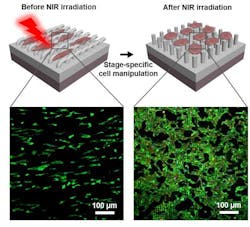'Smart' near-IR platform programs vascular endothelium remodeling
Vascular regeneration has shown importance and promise in cardiovascular disease treatment. Within the vascular regeneration process, endothelium remodeling (the formation of a confluent vascular endothelial cell monolayer on the lumen) plays a vital role. However, rapid endothelialization using existing synthetic biomaterials or engineering methods is very challenging, as vascular endothelium remodeling is a complicated and dynamic process.
Throughout the endothelialization process of native blood vessels, vascular endothelial cells and progenitor cells are first recruited/migrated to the regeneration sites, followed by the adhesion and spreading of vascular endothelial cells to form a confluent vascular endothelial cell monolayer. In the human body, this process is implemented through extracellular matrix (ECM)-mediated stepwise modulation of vascular endothelial cell functions at different stages. Nevertheless, existing synthetic biomaterials usually exhibit static properties, which cannot offer dynamic and particularly on-demand inducements for manipulating specific vascular endothelial cell functions at different stages of endothelium remodeling.
To realize the on-demand manipulation of vascular endothelial cell functions for meeting the requirements of endothelium remodeling, a team of scientists at the Institute of Advanced Technology of the Chinese Academy of Sciences (Shenzhen, China) has demonstrated a remote-controlled "smart" platform that effectively directs programmed vascular endothelium remodeling in a temporally controllable manner. The team developed a bilayer platform with programable surface topographies using a shape-memory polymer and gold nanorods as a photothermal agent. The bilayer platform possesses originally stable anisotropic microgroove array topography at the physiological environment, which can significantly direct cell polarization and thereby enhance the collective migration of vascular endothelial cells. Upon 10 s of near-infrared (near-IR) light irradiation, the heat generated on the bottom layer can induce the change in the surface topographies of the platform from the original anisotropic microgroove array to the permanent isotropic micropillar array. Correspondingly, the focal adhesion and spreading of vascular endothelial cells can be subsequently promoted at the later stage of endothelialization by the platform with altering topographies. The platform with remote-controlled "smart" properties in turn promotes different functions of a vascular endothelial cell, which mimics the dynamic ECM-mediated effects throughout the endothelialization process using synthetic biomaterials.
"Traditionally, biomaterials and tissue engineering scaffolds offer suitable platforms to support cell attachment and ingrowth," explains Dr. Xuemin Du, corresponding author on the work. "Nowadays, we aim to develop biomaterials with dynamic properties to actively modulate different cell functions in specific spatiotemporal manners, just like the native ECM in our bodies. We believe the biomaterials with dynamic properties will significantly contribute to the progresses of wound healing and complex tissue/organ regeneration."
Full details of the work appear in the journal National Science Review.
Source: EurekAlert press release – February 5, 2020
Got biophotonics-related news to share with us? Contact Lee Dubay, Associate Editor, BioOptics World
Get even more news like this delivered right to your inbox
